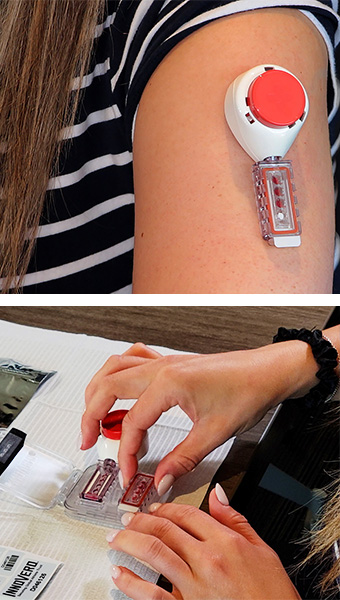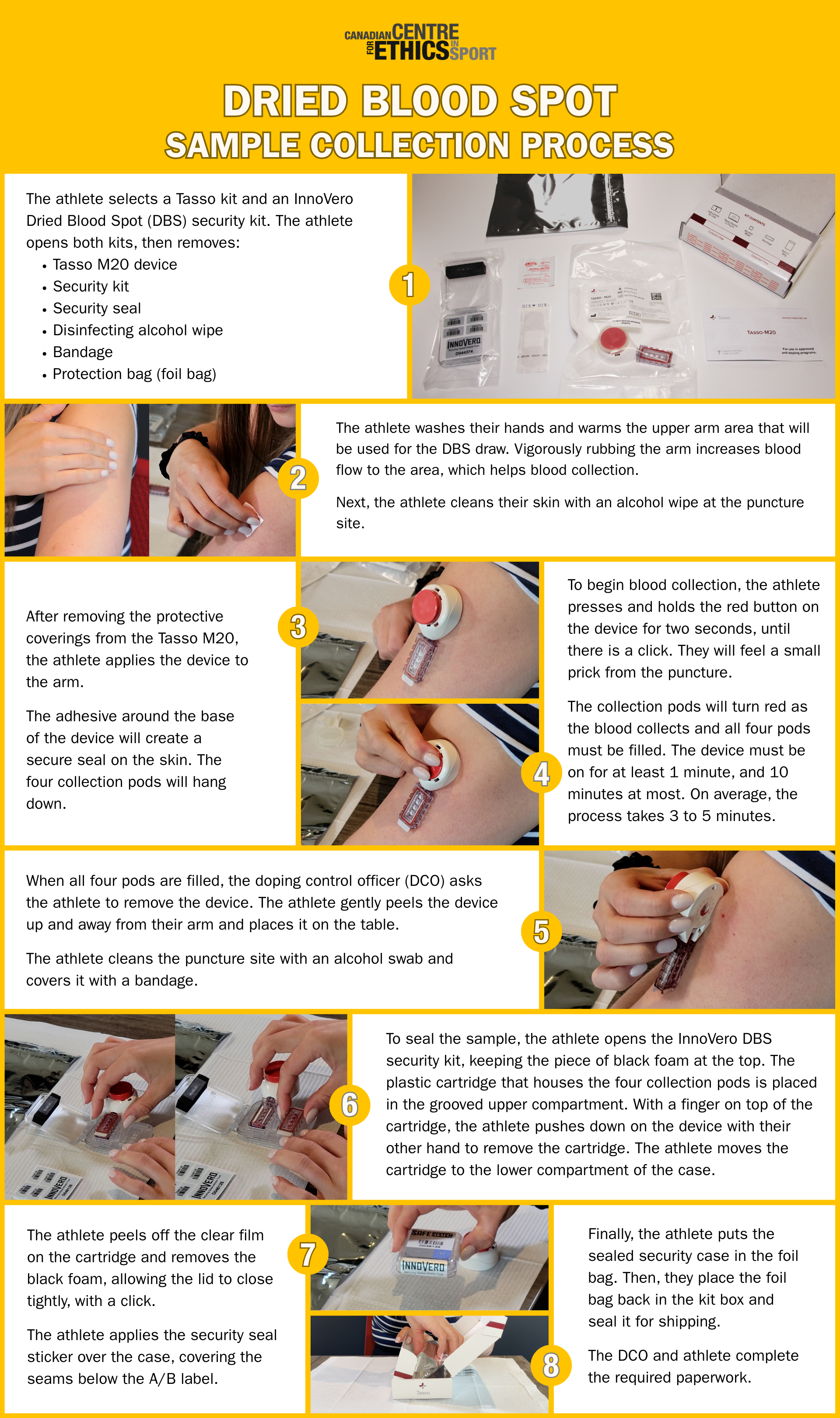
Dried blood spot (DBS) testing is an innovative new way to collect blood samples for anti-doping tests.
DBS involves a small skin puncture, typically to the upper arm, that collects a few drops of blood that are absorbed by special filter paper cards in pods for laboratory analysis. The CCES uses the Tasso-M20 device to collect the DBS samples.
To collect a sample, athletes will follow a doping control officer's (DCO) instructions and operate the device themselves.
DBS does not replace urine or whole blood testing.
Sample Collection Process
The DBS sample collection process follows the same basic steps as urine and venous blood collection:
- Notification
- Equipment selection
- Sample collection
- Package and secure the sample
- Documentation

Background Information
Dried blood spot (DBS) testing is a relatively new method for collecting blood samples. It involves collecting a few drops of blood, usually from the upper arm or fingertip instead of a vein. The drops are absorbed into special filter paper cards that are housed in pods for lab analysis. In Canada, the Tasso-M20 device is used to collect the sample. Athletes operate the device themselves, following instructions from a doping control officer (DCO).
Athletes might give only a DBS sample, or in addition to a urine sample and/or venous blood sample. DBS doesn’t replace urine or venous blood testing.
DBS is a World Anti-Doping Agency-approved sample collection method, like urine and blood collection. While the CCES is using DBS, not all anti-doping organizations or major event organizers may include it in their current testing program.
Yes. As with urine and venous blood samples, an adverse analytical finding following the analysis of a DBS sample may result in an anti-doping rule violation.
Yes. All athletes under the jurisdiction of the Canadian Anti-Doping Program (CADP) can be selected to provide a urine, venous blood, or DBS sample.
No. DBS is meant to supplement testing, not replace urine or venous blood sample collection.
Process
The CCES uses the Tasso-M20 device, typically placed on an athlete’s upper arm. The device has a small needle that will puncture the skin, collecting four pods of blood, which are then sealed and shipped to a WADA-accredited laboratory for analysis. The athlete will operate the Tasso-M20 device themselves, so only a doping control officer (DCO) needs to be present. Blood collection officers (BCO) are not involved in DBS testing. Other organizations may use a device that collects the blood through a finger prick.
Consult step-by-step DBS sample collection procedure above, or download the infographic.
A venous blood sample requires 3 to 5 mL of blood to be collected from an athlete’s vein by a certified phlebotomist. Then, it is sent to a laboratory using temperature-controlled shipping.
In comparison, a DBS sample is a small amount of blood, collected by a device that is operated by the athlete. A blood collection officer (BCO) is not required, and the sample is easier to ship to a laboratory.
Other differences between venous blood and DBS sample collection include:
- Athletes don’t have to be seated for 10 minutes prior to DBS collection so the process can be completed faster.
- The Tasso-M20 device uses a smaller needle than the venipuncture so it is less painful and less invasive.
- The amount of blood collected with DBS is about 25 times less than venous puncture so collection is often faster.
- Athletes operate the device themselves so the process may be more comfortable.
The DBS procedure involves a slight puncture of the skin with a small needle, so a BCO is not required. The athlete can operate the device on their own, following instructions and guidance from a doping control officer.
A venous blood draw involves puncturing a vein and collecting a larger amount of blood, which requires personnel who are trained in the blood draw procedure and after care.
Like any other method of sample collection, the length of the process depends on an athlete’s ability to provide a sample.
To complete the collection, all four pods on the collection cartridge need to be filled. This usually takes 3 to 5 minutes once the device is applied.
The DBS device must be secured to the arm for at least 1 minute and 10 minutes at most. If all four pods are not filled after 10 minutes, a new device will be selected, and the process is repeated in an effort to fill all four pods.
While the risks of DBS are very minimal compared to venous puncture, an athlete may feel light-headed, nauseous, or unwell at the sight of blood.
The device creates a small puncture, so there may be some slight soreness in the arm.
As with any sample collection method, an athlete can discuss modifications with the sample collection personnel during the procedure if required.